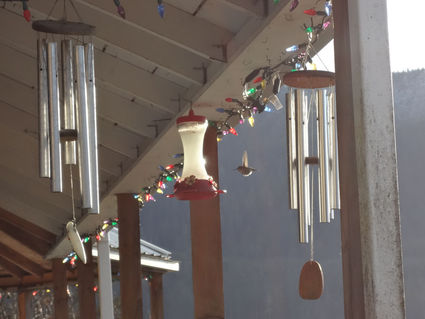Annual bird count affected by adverse weather

Dan Rudy/ Wrangell Sentinel
An Anna's hummingbird locates some nectar outside a Wrangell home Jan. 3, during the annual Audubon Bird Count.
Wrangell bird-watchers braved crisp weather and rough water on Jan. 3 to participate in this year's 115th annual Audubon Society Christmas Bird Count.
Volunteers around the country pick a date between Dec. 14 and Jan. 4, and have 24 hours to record as many birds as possible within a seven-mile radius of a given point. Information is then submitted to the Audubon Society for record-keeping.
Alaskans have been participating in the annual count since 1990, though the Audubons have been active in the state since 1941. Last year some 37 counts were held around the state, with more than 1,000 observers spotting 124,854 specimens of 139 different species of bird.
Fifteen birders participated in Wrangell's count, taking five routes within their designated 15-mile diameter circle. Between them, 51 different species of bird were identified, with 3,485 individual specimens counted in all.
"It was pretty much the normal birds we see," said Dennis Strom, a birder who conducted the water count.
Figures are down from last year, where 19 participants counted 5,620 birds of 52 different species. Strom said weather played a role. It had been a very windy day, and rough water prevented them from getting down the Back Channel in their boat.
Strom also noticed feeder counts were lower than usual this year, attributing that to milder winter weather. While he may go through 200 pounds of seed during the winter in his own feeder, this year he said it'll be half that.
Among the birds counted were a big flock of Western grebes; some cormorants; two species of gull, including one white-winged variety normally found around the Gulf of Mexico; 892 goldeneye mallards; 130 ravens; 291 crows; and 182 Dark-eyed Juncos.

The species found around Wrangell are predominately water birds, but once in a while an atypical variety will turn up. Among the count, an Anna's hummingbird was counted by Bonnie Demerjian and Carol Ross, rather than the more usual Rufus type.
"Every once in awhile in the winter we have these stray Anna's," Demerjian explained.
The count takes place in the winter time because seasonally migratory birds have by then tended to return south.
"It's nice to see what's resident in North America," said Demerjian, one of the counters. "We like to think of them as 'our' birds, but they spend more time in Central and South America."
She also participates in the Audubon's Great Backyard Bird Count each February.
"That's supposed to be a late-winter survey of what's around," she explained.
Bird-watchers are attracted to the pastime for a variety of reasons.
Ross has resumed bird-watching in the past decade or so, but had initially taken an interest in it in sixth grade. Her teacher in Ellensburg, Wash., Miss Munson, first got Ross started.
"I was so lucky to have her as a teacher," Ross recalled. "She got many people in the class interested in birding."
Strom enjoys being outdoors, as well as the birds themselves. He said it has been a hobby of his for over half a century.
It is an exercise in attention, as well; one has to be sharp-eyed to pick out the multiple flutters of Oregon Dark-eyed juncos collecting in trees and hopping about the underbrush around town.
"There's always something different about birding," Ross said. "It really is kind of an intellectual exercise."



Reader Comments(0)